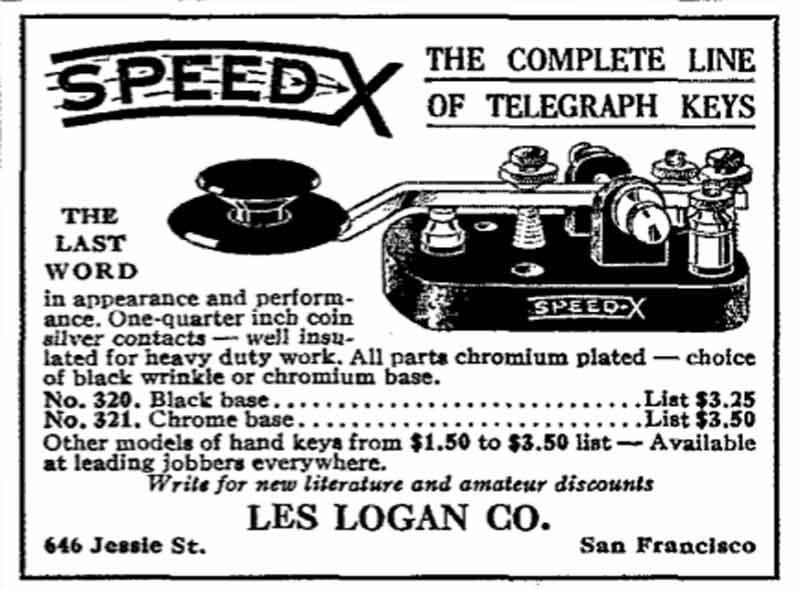
Monday, Nov. 21, 2016, 9:49 p.m. — Just returned to the library from the shack where I waited for the start of the CW net I usually check into 9 p.m. nightly. Unfortunately, for the second night in a row, the 80-meter band was long and I couldn’t copy the net control station. I was getting pairs of characters during the preamble tonight … just like last night … but not good copy. I’ve tried to check in other times when the band was long, and my sigs were too weak as well for reliable copy.
 I did take a time to scan the band for signals I could hear … about 2-1/2 kcs down there were a couple of W8s having a QSO. I still have my Les Logan Speed-X Model 500 on the operating desk, and probably will keep in there a while longer. I did take time to snap some pics of the key before the net was to start.
I did take a time to scan the band for signals I could hear … about 2-1/2 kcs down there were a couple of W8s having a QSO. I still have my Les Logan Speed-X Model 500 on the operating desk, and probably will keep in there a while longer. I did take time to snap some pics of the key before the net was to start.
SPEED-X HISTORY 101. While I was digging around under the operating desk recently, I rediscovered a handcrafted wooden case that contained an early Stewart Johnson Speed-X key. I don’t have photos, but will because the key is in beautiful condition and the case is pretty impressive.
The Stewart Johnson Speed-X keys did not have labels, but they did share the same post-and-disc dampers that later Speed-X keys used. The Speed-X key in the homebrew case is black crackle, both the base and pivot frame.
According to sources on the Web, Speed-X’s beginnings date to 1927, when the Electro Manufacturing Co. in Fresno, Calif. began manufacturing keys with the distinctive “T-bar” pivot frame. The Electro Bug key was unique too because it used a solenoid to assist the making of dits, and apparently, the solenoid helped make the key usable on a wide variety of landline applications. They also manufactured a key without the solenoid called the Electro Bug Jr.
In 1934, Stewart Johnson bought the company and moved it to San Franciso, changing the name to Speed-X Radio Manufacturing Co. These early  Speed-X keys lack nameplates that identify them as Speed-X keys, and most of them had unique-shaped thumb pieces. According to sources, some of the early Speed-X keys were sold under the name San Francisco Radio Exchange and were equipped with labels. Early Speed-X keys were also sold through Sears & Roebuck.
Speed-X keys lack nameplates that identify them as Speed-X keys, and most of them had unique-shaped thumb pieces. According to sources, some of the early Speed-X keys were sold under the name San Francisco Radio Exchange and were equipped with labels. Early Speed-X keys were also sold through Sears & Roebuck.
Johnson sold the company to Les Logan in 1937. For the next 10 years, must have produced a lot of keys, given how common Les Logan keys are today on eBay. Les Logan sold Speed-X to EF Johnson in 1947, which opened a new chapter of the company’s history.
EF Johnson put its unique touch in a revamping of the Speed-X designs. The T-bar pivot frame disappears; it is replaced from an assembled top and bottom plate created in a shape similar to the EF Johnson label found on the keys (the label was mounted on the top plate of the pivot assembly).
EF Johnson revamped the paddles, dropping the “bullseye” design and eventually replacing them with a slightly contoured paddles of slightly different shape and made from a hard plastic rather than a bakelite-like material. The company also revamped the weights the bugs used, doing away with the set screws found on most all bugs and using a tensioned clip that held the weight in place. This system of securing weights was (in my view) the easiest system to adjust of any key manufacturer I’ve used.
EF Johnson continued the manufacture of Speed-X keys — both bugs and straight keys — until the company was sold to William Nye in 1972. Nye has continued to manufacture straight keys for the past 44 years — not a bad record! As noted on the Morse Express website, if you look at the Speed-X keys Nye sells today (the rectangular-based key), they’re virtually the same as those sold and advertised in QST in the back of the January 1938 issue.
-30-

